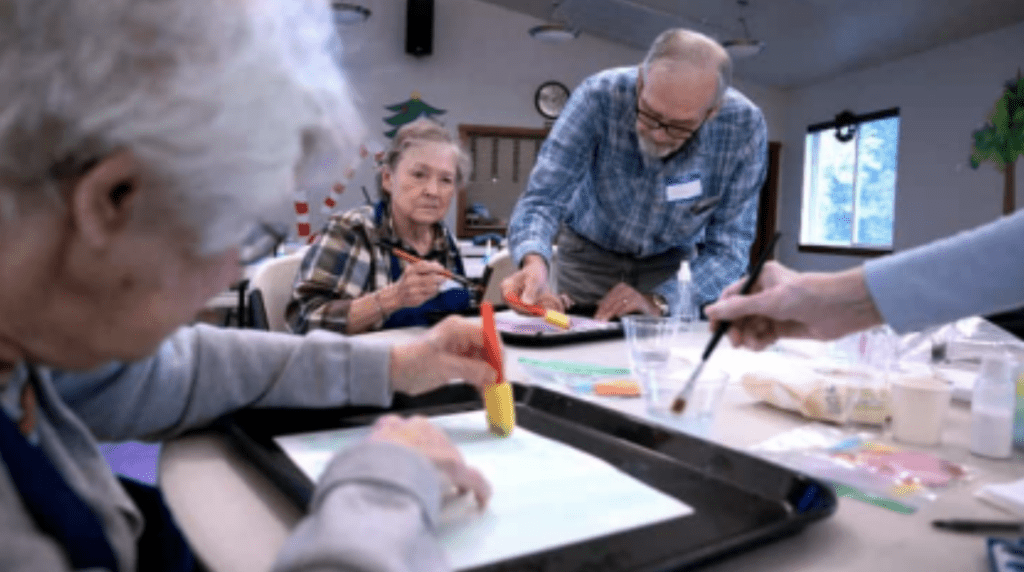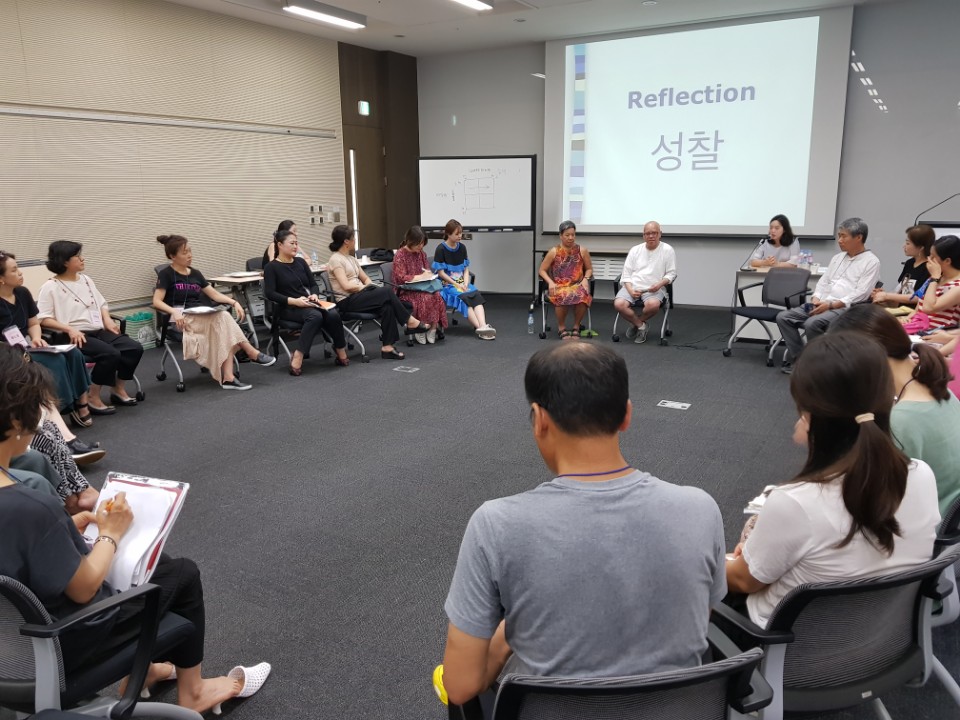FAQ
We have gathered information on the successes and challenges in implementing the OMA program from previously trained OMA facilitators and used that to compile a list of Frequently Asked Questions. We hope you find these a valuable source of information as you work to implement OMA at your facility.
I just got home from training, but I don’t know where to begin. Where do I start if I want to implement OMA now?
We recommend that you start now, reach out, start small, and stay focused.
- Start now. When you leave training, you will be energized and motivated. The longer you wait to begin implementation, the more difficult it will be to maintain that same level of excitement and find the impetus you need to initiate.
- Begin by reaching out to local educational institutions (local high schools, universities, community colleges, etc.) and other volunteer organizations where you might be able to reach out to prospective volunteers. After initial emails and calls, plan to meet them in person. It’s very difficult for others to understand the OMA program and its impact without face to face conversation and OMA visuals, such as examples of OMA art.
- When reaching out to prospective organizations for volunteers, avoid explaining OMA as an “art program.” Present it as an opportunity for volunteers to engage in a fun, unique intergenerational opportunity which will allow them to collect volunteer hours. Also emphasize that including a reflection on this experience in college and graduate school admission applications and interviews can strengthen a student’s application.
- If reaching out to teachers or professors to recruit students, emphasize that the program is “ready-made” for students and will not require additional work on the part of the instructor; all that is required is that students arrive each week and potentially submit journal entries regarding their experiences.
- Target departments such as Education, Psychology, Social Work, Speech Pathology, Pre-Med, and Nursing, but don’t limit yourself strictly to those areas.
- Seek out volunteer coordinators on college campuses.
- Seek out programs that require student internships and volunteer hours. o Consider starting small and utilizing some of the staff members at your facility such as STNA’s and members of the Activities Staff.
- Start small. Consider doing just 4-5 pairs and a total 5-6 weeks to begin. If the sessions and art exhibition go well, increase your total number pairs and number of sessions for the next cycle.
- Stay focused. Set aside specific dates and times to use for OMA planning and implementation purposes, and stick to them. Treat OMA like your other obligations such as board meetings. Making OMA part of your regular routine will eventually begin to feel much more natural.
How can we get buy-in from CEOs and other members of management in long-term care to support the work we do through OMA?
There are multiple ways this can be achieved. A combination of the following approaches is recommended. Some of these approaches would be used before you have started OMA at your site/organization; other approaches are used after you have initiated the OMA program. Be prepared to continually “sell” OMA to your CEO and other board members on a regular basis (e.g. presenting the work you are doing at a board meeting). For sites in Ohio: remind board members that OMA is one of eight “Quality Improvement Projects” which can be used to fulfill state requirements to maintain licensure.
- Attend an OMA art show. Find the nearest operating OMA site and invite your CEO and/or other members of management to the OMA art show at that site.
- Explain the ways in which OMA can be used effectively for people with dementia (PWD) across all levels of care (i.e. independent living, assisted living, and skilled nursing) and to build community among individuals across differing levels of care.
- Present evidence of effectiveness and impact.
- Refer back to the published research in peer-reviewed journals to review data and program results.
- Share materials from OMA as proof of its success. Examples include video footage of sessions and artwork that was created through your program.
- Show before and after mood data displaying how residents felt directly before and after OMA. This data can be collected using the “OMA Artist Feedback” sheet provided to you in the “additional resources” section of your facilitator training binder.
- Consider the evidence-base for OMA (theory and research). Determine how you might collect additional evidence related to the impact of OMA on your artists. Ask nursing staff to provide observations/data related to how OMA has impacted your artists. Have they observed any changes in the behaviors of the artists since OMA was introduced? Has the use of psychotropic/anti-anxiety medications been reduced since its implementation
- Ask family members of your OMA artists to provide a testament to the difference OMA has made in their loved ones’ lives, and share those sentiments.
How will I know which residents to select as OMA artists?
There is no hard and fast rule for the selection of OMA artists, but be mindful of the fact that this program is designed specifically for people with dementia. Work with other staff members (nursing staff, social workers, therapists, etc.) for additional perspective when determining which residents might make the best candidates. Be sure to have an alternate artist list as well.
Selection criteria may include any of the following factors:
- Does the resident have a diagnosis of dementia?
- What are the resident’s interests?
- How often does the resident have visitors? How much family support does the resident have?
- How engaged is the resident in other activities? Consider targeting individuals who typically do not come out of their rooms for activities and would benefit most from one-on-one time and attention.
- Does the resident have severe limitations in sensory/motor abilities? Can you provide modifications to accommodate for limitations in range of motion? Examples: Lap trays; Thick foam grips for tools such as paint brushes
- How advanced is the dementia? People in the later stages are often still able to successfully participate in OMA. Consider incorporating at least a handful of these individuals; they may surprise you!
- Health status: Can you include bed-bound residents if you take all the materials to their room?
Should I include my “line staff” (e.g. housekeeping, nurse aides, dietary staff, etc.) in OMA training and introduce them to the methodology?
Absolutely! This is an integral part of getting “buy-in” from the entire staff to spread OMA’s philosophy across your entire campus.
Should staff members who volunteer in OMA do so “on the clock” or “off the clock”?
This must be decided at the discretion of each individual facility/organization. OMA sites have handled this issue in a variety of ways:
- Allow any staff member to be trained as an OMA volunteer and complete one session on the clock. If they enjoy the experience and would like to return for additional sessions, have them do so on their own time.
- Allow staff members to serve as OMA volunteers on the clock.
- Make sure staff members know they must complete all necessary work before participating
- Be flexible. Allow staff volunteers to alter the time of their lunch break if necessary.
- Be helpful. Bring staff members together and set the expectation that if one staff member is volunteering, the others must work as a team to cover the OMA volunteer for the hour they are gone.
- Allow staff members to serve as OMA volunteers “off the clock” only.
What kind of impact does OMA have on individual residents?
A variety of positive outcomes have been observed/identified in OMA artists. Of course the impact varies among individuals, but impacts may include:
- A greater sense of self
- Increase in creativity and self- expression
- Increased opportunities for choice/autonomy
- Increased self- esteem and willingness to take risks or try new things
- A sense of empowerment
- Diminished experience of pain
- Improvements in fine and gross motor skills
- Increased communication
- Enjoyment and fun!
How does “culture change” manifest after OMA is introduced?
When staff members are trained to implement OMA’s philosophy and methodology, you may see a “spilling over” effect. Staff members may begin to critically examine their interactions with residents in ways they hadn’t in the past. Examples include:
- Activities staff re-envisioning art projects to include higher-quality materials to create art projects that promote dignity through self-expression.
- Utilization of more adult appropriate materials out of respect for residents.
- Decreased use of “elderspeak” and increased use of person-first/person-centered rather than disease focused communication.
- Incorporation of additional programming that is appropriate for PWD (e.g. Music and Memory, TimeSlips Creative Storytelling)
How can one person take on the challenge of implementing OMA on a larger scale (i.e. in multiple communities, at different levels of care, etc.)?
- We highly recommend that you gather a group of other individuals who can assist you in your implementation of OMA. Ideally, the number of individuals you choose should include one more person than you think you will need. This will increase the likelihood that your sessions will run smoothly even if one of your fellow leaders is absent, or a volunteer doesn’t show up and an artist needs a partner at the last minute.
- Don’t be afraid to delegate tasks to other members of your team.
- Consider implementing OMA on a rotation basis. Begin with a session at site A for the first week, site B for the second week, and site C for the third week. Repeat until each location has had at least 3 or 4 art-making sessions. Incorporate all sites in a combined art show.
- Utilize your volunteers – especially returning volunteers. Incentivize them by presenting an opportunity to assist with the OMA process, including play time, session/materials preparation, setup, and clean-up.
Can OMA be displayed as part of our facility’s marketing materials to attract potential residents in the future?
Absolutely! Some facilities with OMA programs use photographs and other materials from their art shows to generate community interest in a multitude of ways. Be sure to tap into your marketing department and see what they have to offer.
- Use social media: post pictures of OMA sessions and OMA art on your Facebook and Instagram pages.
- Post OMA information on your facility’s webpage.
- Share your experiences with your local newspaper.
- Garner additional exposure through partnerships with local organizations and universities where you may be recruiting volunteers.
- Word of mouth works! The impact OMA makes reverberates throughout communities when good work is being done.
I am not directly employed by the facility/facilities where I want to implement OMA. How can I get my foot in the door to provide OMA? Won’t they just send their own staff to be trained as facilitators?
If a long-term care community decides to send staff members to be trained as OMA facilitators, that is their decision. However, you have a variety of factors working to your benefit:
- Long-term care communities often have high turnover rates in all areas of staffing, including activities positions. Incentivize those organizations to use you as their OMA facilitator to reduce part of that turnover.
- If long-term care communities can use you as their OMA facilitator, they won’t need to take on the additional expense of training their own staff members.
I am experiencing challenges recruiting volunteers. What suggestions do you/other facilitators have for increasing my volunteer base?
There are several reasons why recruiting volunteers can be challenging. These include 1) the the long-term nature of the commitment to being an OMA volunteer in comparison to other volunteer/service opportunities; 2) sessions must be scheduled so that they do not conflict with volunteer school/work schedules; and 3) high school/college students may need transportation to the site.
There are a number of tips/strategies/solutions to meet this challenge.
- Identify who would be good partners. It’s important to understand the partner’s needs and how collaboration with OMA can meet those needs. Meeting with the potential partner in person is crucial. Partners identified by facilitators included women’s groups, Goodwill (those with mild disabilities were successful volunteers), job coaches at local agencies, living/learning dorms/communities at universities.
- Identify an individual within the school/university (counselor, school nurse, teacher/faculty member, scholarship coordinator, service-learning coordination etc.) and meet with this individual face-to face. Discuss how participation in OMA could meet organization/student needs.
- Identify a core group/university major/high school or university class/club and schedule sessions around their schedule. For example, one site schedules around the social work students’ semester schedule as they comprise their core group of volunteers.
- Explore possibilities of collaborating with charter schools/home school groups in your area. Charter schools may have limited funding for the arts and collaboration with OMA may meet multiple needs for the school. One organization is partnering with charter schools which have made OMA volunteering mandatory for an introduction to public health class.
- When introducing OMA explain the OMA philosophy and methodology. The focus on development of empathy and communication/relationship skills often provides a compelling rationale for collaboration.
- If possible have individuals from the university/school/collaborating organization attend the training. This increases the understanding of the program and increases “buy-in”.
- As part of the meeting with potential partners show the short video of Student Perspectives. This is on the OMA website under the Videos tab. The video is a powerful testament to the impact of OMA on student growth, personal and professional development.
I have had several 8-week OMA “terms” and art shows and am becoming overwhelmed. How can I more effectively manage the workload?
Running a high quality program such as OMA is time consuming. It’s vital that you gain assistance of others to sustain your work. Consider social work interns, marketing person(s) in the facility, volunteer coordinators, facility/organization volunteers, and independent living residents.
I am interested in having an auction to help support our OMA program but am not sure how to go about this. Do you have any resources/tips on holding a successful OMA auction?
There are several important considerations in planning and implementing a successful auction.
- Secure Consent/Agreement to auction art pieces
- It’s important to clearly communicate the auctioning of artwork to families
- Use the release form that families/POA can sign
- Show the OMA video at the art show to communicate the worth of the program
- Emphasize that proceeds will support continuation of the program
- Determine the auction approach/method you will use. Several variations that organizations have implemented successfully include:
- Art show is displayed for several weeks and silent auction occurs during that entire time
- Silent auction occurs during the 2-hour art show reception only.
- Artist selects the piece he/she wants to donate for the auction. Silent auction occurs the day of the art show reception and winners are announced during the reception. The artist is then available to meet the winner.
- Consider your goal for revenue raised through the art show auction
- Facilities represented reported raising between $500 (8 pieces) and $5,000 (70 pieces) through the auction
- Facilitators suggested inviting individuals such as aging professionals, local bankers, Foundation Directors, community-minded groups such as the Kiwanis and Rotary Clubs to the show/auction as possible means of increasing revenue raised.
- Use printed auction forms. Necessary forms used for the auction are available on the OMA Website, under “Facilitator Resources” and select “Other Resources.”
- Auction Registration Form
- Bid Form


